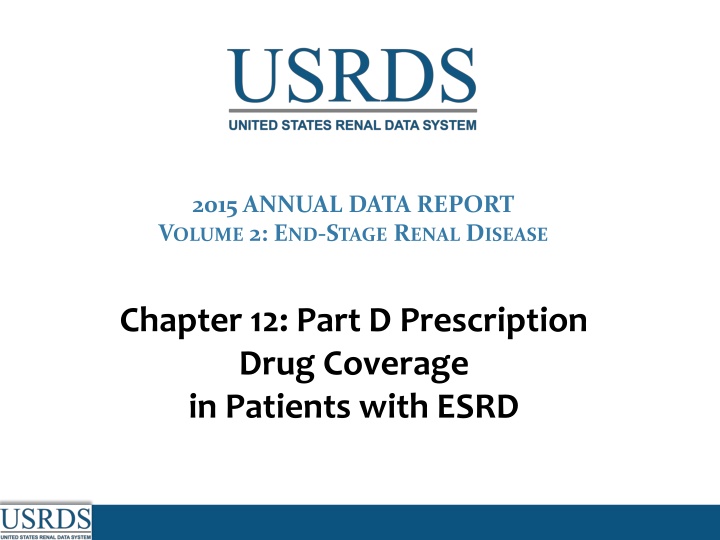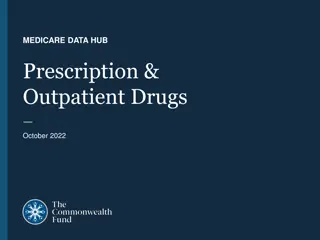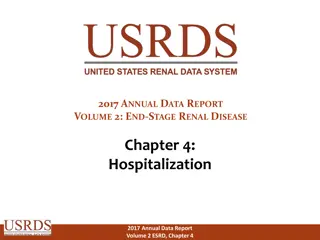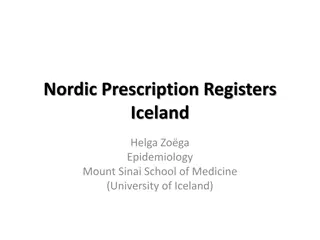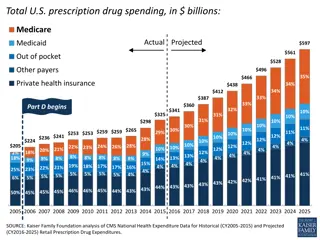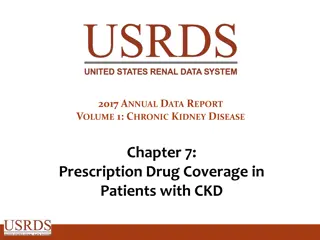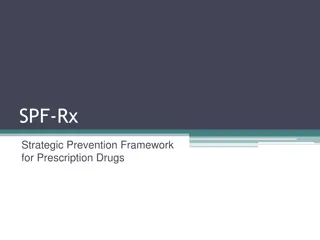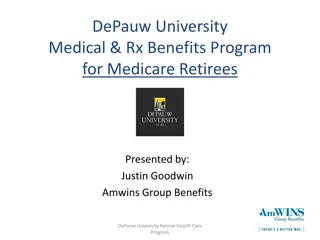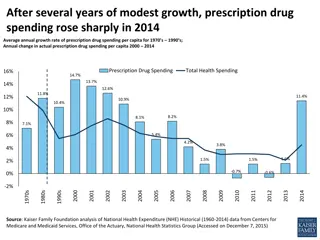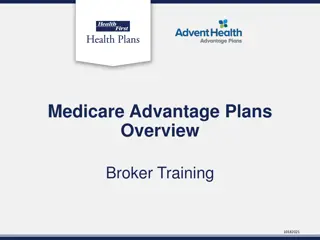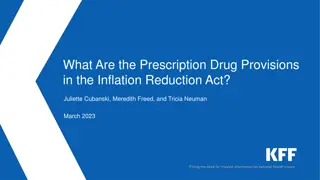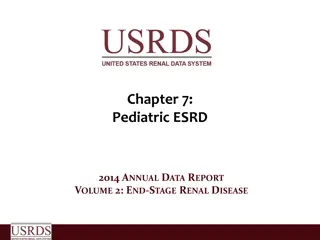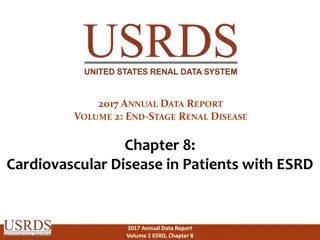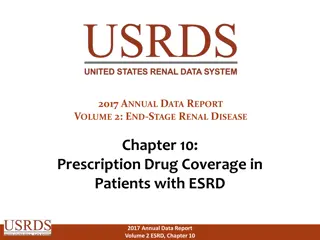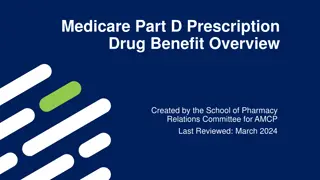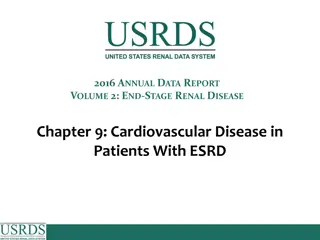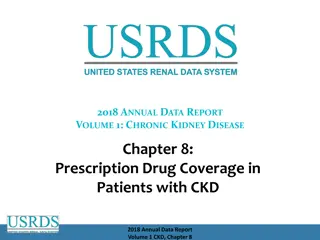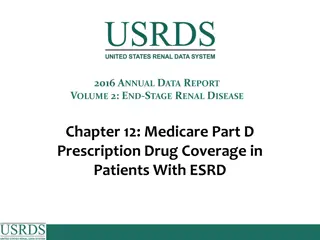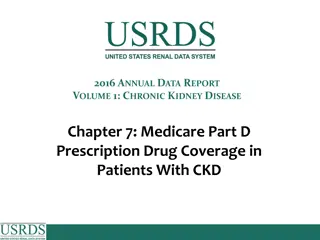Prescription Drug Coverage in Medicare ESRD Enrollees
This data report analyzes the sources of prescription drug coverage in Medicare ESRD enrollees, focusing on different populations, ages, modalities, and race/ethnicities. It provides insights into medication access for individuals with end-stage renal disease.
Download Presentation

Please find below an Image/Link to download the presentation.
The content on the website is provided AS IS for your information and personal use only. It may not be sold, licensed, or shared on other websites without obtaining consent from the author.If you encounter any issues during the download, it is possible that the publisher has removed the file from their server.
You are allowed to download the files provided on this website for personal or commercial use, subject to the condition that they are used lawfully. All files are the property of their respective owners.
The content on the website is provided AS IS for your information and personal use only. It may not be sold, licensed, or shared on other websites without obtaining consent from the author.
E N D
Presentation Transcript
2015 ANNUAL DATA REPORT VOLUME 2: END-STAGE RENAL DISEASE Chapter 12: Part D Prescription Drug Coverage in Patients with ESRD
Figure 12.1 Sources of prescription drug coverage in Medicare ESRD enrollees, by population, 2013 Data source: 2013 Medicare Data, point prevalent Medicare enrollees alive on January 1, 2013. Abbreviations: ESRD, end- stage renal disease; HD, hemodialysis; LIS, Low-income Subsidy; Part D, Medicare Part D prescription drug coverage; PD, peritoneal dialysis; Tx, kidney transplant. Vol 2, ESRD, Ch 12 2
Figure 12.2 Sources of prescription drug coverage in Medicare ESRD enrollees, by age & modality, 2013 (a) Dialysis Patients Data source: 2013 Medicare Data, point prevalent Medicare enrollees alive on January 1, 2013. Abbreviations: ESRD, end- stage renal disease; LIS, Low-income Subsidy; Part D, Medicare Part D prescription drug coverage. Vol 2, ESRD, Ch 12 3
Figure 12.2 Sources of prescription drug coverage in Medicare ESRD enrollees, by age & modality, 2013 (b) Transplant Patients Data source: 2013 Medicare Data, point prevalent Medicare enrollees alive on January 1, 2013. Abbreviations: ESRD, end- stage renal disease; LIS, Low-income Subsidy; Part D, Medicare Part D prescription drug coverage. Vol 2, ESRD, Ch 12 4
Figure 12.3 Sources of prescription drug coverage in Medicare ESRD enrollees, by race/ethnicity & modality, 2013 (a) Dialysis patients Data source: 2013 Medicare Data, point prevalent Medicare enrollees alive on January 1, 2013. Abbreviations: Blk/Af Am, Black or African American; ESRD, end-stage renal disease; LIS, Low-income Subsidy; Part D, Medicare Part D prescription drug coverage. Vol 2, ESRD, Ch 12 5
Figure 12.3 Sources of prescription drug coverage in Medicare ESRD enrollees, by race/ethnicity & modality, 2013 (b) Transplant Patients Data source: 2013 Medicare Data, point prevalent Medicare enrollees alive on January 1, 2013. Abbreviations: Blk/Af Am, Black or African American; ESRD, end-stage renal disease; LIS, Low-income Subsidy; Part D, Medicare Part D prescription drug coverage. Vol 2, ESRD, Ch 12 6
Figure 12.4 Distribution of Low-income Subsidy categories in Part D general Medicare & ESRD patients, 2013 Data source: 2013 Medicare data, point prevalent Medicare enrollees alive on January 1, 2013. Abbreviations: ESRD, end- stage renal disease; Part D, Medicare Part D prescription drug coverage. Vol 2, ESRD, Ch 12 7
Table 12.1 Medicare Part D enrollees (%) with or without the Low-income Subsidy, by age & race, 2013 Peritoneal dialysis General Medicare All ESRD Hemodialysis Transplant Part D without LIS Part D without LIS Part D without LIS Part D without LIS Part D without LIS Part D with LIS Part D with LIS Part D with LIS Part D with LIS Part D with LIS White All ages 26.0 74.0 55.1 44.9 58.6 41.4 49.1 50.9 47.8 52.2 20-44 88.9 11.1 87.8 12.2 91.0 9.0 88.4 11.6 82.4 17.6 45-64 52.3 47.7 70.1 30.0 75.5 24.5 63.4 36.6 56.9 43.1 65-74 15.5 84.6 40.6 59.4 48.6 51.4 25.2 74.8 22.1 78.0 75+ 20.4 79.6 34.8 65.2 37.6 62.4 17.3 82.7 18.6 81.4 Black/Af Am All ages 59.8 40.2 75.0 25.0 76.7 23.3 71.9 28.1 66.0 34.0 20-44 93.6 6.5 92.0 8.0 93.7 6.3 91.4 8.6 86.0 14.0 45-64 75.3 24.7 80.2 19.8 82.6 17.4 73.8 26.2 68.8 31.2 65-74 43.7 56.3 60.4 39.6 64.1 35.9 42.7 57.4 41.6 58.4 75+ 52.0 48.0 61.1 38.9 62.7 37.4 36.7 63.3 41.7 58.3 Other race All ages 59.3 40.7 71.4 28.6 75.8 24.2 60.4 39.6 60.9 39.1 20-44 87.5 12.5 87.3 12.7 90.8 9.2 84.8 15.2 80.8 19.3 45-64 62.1 37.9 75.6 24.4 80.4 19.6 62.0 38.0 66.0 34.0 65-74 49.9 50.1 61.5 38.5 68.2 31.8 42.6 57.4 47.6 52.5 75+ 63.6 36.4 68.3 31.7 71.8 28.2 54.8 45.2 44.9 55.2 Data source: 2013 Medicare data, point prevalent Medicare enrollees alive on January 1, 2013. Abbreviations: ESRD, end- stage renal disease; LIS, Low-income Subsidy; Part D, Medicare Part D prescription drug coverage. Vol 2, ESRD, Ch 12 8
Table 12.2 Medicare Part D parameters for defined standard benefit, 2008 & 2013 2008 2013 Deductible After the deductible is met, the beneficiary pays 25% of total prescription costs up to the initial coverage limit. $275 $325 Initial coverage limit The coverage gap ( donut hole ) begins at this point. The beneficiary pays 100% of their prescription costs up to the out-of-pocket threshold $2,510 $2,970 Out-of-pocket threshold $4,050 $4,750 The total out-of-pocket costs including the donut hole Total covered Part D prescription out-of-pocket spending: (including the coverage gap). Catastrophic coverage begins after this point. $5,726.25 $6,733.75 Catastrophic coverage benefit $2.651 Generic/preferred multi-source drug $2.25 $6.601 Other drugs $5.60 1plus a 52.50% brand name medication discount 2013Example: $325 (deductible) $275 $325 +(($$2970-$325)*25%)(initial coverage) $558.75 $652.50 +(($6733.75-$2970)*100%)(coverage gap) $3,216.25 $3,763.75 Total $4,050.00 $4,750.00 (maximum out-of-pocket costs prior to catastrophic coverage, excluding plan premium) The catastrophic coverage amount is the greater of 5% of medication cost or the values shown in the chart above. In 2013, beneficiaries were charged $2.65 for those generic or preferred multisource drugs with a retail price less than $53 and 5% for those with a retail price over $53. For brand name drugs, beneficiaries paid $6.60 for those drugs with a retail price less than $132 and 5% for those with a retail price over $132.Table adapted from http://www.q1medicare.com/PartD-The-2013-Medicare-Part-D-Outlook.php. Vol 2, ESRD, Ch 12 9
Table 12.3 General Medicare & ESRD patients enrolled in Part D (%) General Medicare All ESRD Hemodialysis Peritoneal dialysis Transplant 2011 61.01 68.93 73.17 61.83 57.15 2013 68.68 74.21 78.23 67.31 63.46 Data source: 2011 and 2013 Medicare data, point prevalent Medicare enrollees alive on January 1. Medicare data: general Medicare, 5% Medicare sample (ESRD, hemodialysis, peritoneal dialysis, and transplant, 100% ESRD population). Abbreviations: ESRD, end-stage renal disease; Part D, Medicare Part D prescription drug coverage. Vol 2, ESRD, Ch 12 10
Table 12.4 Total estimated Medicare Part D costs for enrollees, in billions, 2011 & 2013 General Medicare All ESRD Hemodialysis Peritoneal dialysis Transplant 2011 46.49 1.80 1.45 0.10 0.22 2013 52.75 2.30 1.83 0.14 0.27 Data source: 2011 and2013 Medicare data, period prevalent Medicare enrollees alive on January 1, excluding those in Medicare Advantage Part D plans and Medicare secondary payer, using as-treated model (see ESRD Methods chapter for analytical methods). Vol 2, ESRD, Ch 12 11
Figure 12.5 Per person per year Medicare & out-of-pocket Part D costs for enrollees, 2013 (a) All Part D enrollees Data source: 2013 Medicare data, period prevalent Medicare enrollees alive on January 1, 2013, excluding those in Medicare Advantage Part D plans and Medicare secondary payer, using as-treated model (see ESRD Methods chapter for analytical methods). Vol 2, ESRD, Ch 12 12
Figure 12.5 Per person per year Medicare & out-of-pocket Part D costs for enrollees, 2013 (b) Part D enrollees by Low-income Subsidy status Data source: 2013 Medicare data, period prevalent Medicare enrollees alive on January 1, 2013, excluding those in Medicare Advantage Part D plans and Medicare secondary payer, using as-treated model (see ESRD Methods chapter for analytical methods). Vol 2, ESRD, Ch 12 13
Table 12.5 Per person per year Part D costs ($) for enrollees, by Low-income Subsidy status, 2013 General Medicare All ESRD Hemodialysis Peritoneal dialysis Transplant Part D with LIS Part D without LIS Part D with LIS Part D without LIS Part D with LIS Part D without LIS Part D with LIS Part D without LIS Part D with LIS Part D without LIS Age All 20-44 45-64 65-74 75+ Sex Male Female Race White Black/African American Other race 4,663 1,326 8,522 2,552 8,898 2,563 9,050 2,576 6,551 2,450 5,011 2,157 9,251 2,177 10,407 2,660 9,612 2,428 5,674 1,405 5,830 1,783 9,315 2,851 9,775 2,980 9,350 2,793 7,036 2,479 4,176 1,291 7,499 2,785 7,635 2,783 7,227 2,738 6,888 2,660 3,588 1,256 5,889 2,049 5,999 2,051 5,064 2,094 5,300 2,132 4,788 1,400 8,554 2,548 8,958 2,536 9,346 2,522 6,529 2,521 4,584 1,272 8,488 2,558 8,833 2,604 8,782 2,655 6,580 2,341 4,809 1,320 8,175 2,556 8,532 2,558 9,014 2,648 6,533 2,445 4,470 1,456 9,039 2,539 9,408 2,572 9,014 2,058 6,445 2,520 4,256 1,279 8,132 2,548 8,301 2,600 9,500 3,114 7,066 2,306 Data source: 2013 Medicare data, period prevalent Medicare enrollees alive on January 1, 2013, excluding those in Medicare Advantage Part D plans and Medicare secondary payer, using as-treated model (see ESRD Methods chapter for analytical methods). Vol 2, ESRD, Ch 12 14
Table 12.6 Common drug classes used by Part D-enrolled dialysis patients, by percent of patients, drug class, and net cost, 2013 Percent of patients (%) Net costs ($) Calcimimetic agents 29.1 407,140,771 Statins 46.0 21,788,139 Calcium channel blockers 46.2 15,096,030 Phosphate binder agents 72.5 692,085,189 Beta blockers 65.3 18,672,865 Angiotensin II receptor blockers 43.5 23,391,588 Data source: 2013 Medicare data, period prevalent Medicare enrollees alive on January 1, 2013, excluding those in Medicare Advantage Part D plans and Medicare secondary payer, using as-treated model (see ESRD Methods chapter for analytical methods). Vol 2, ESRD, Ch 12 15
